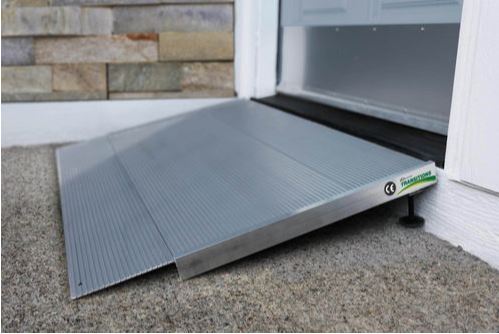
5 Key Factors to Consider When Buying a Threshold Ramp for Wheelchair Users
Threshold ramps are essential mobility aids that provide wheelchair users with a smooth and safe transition over doorways, thresholds, or other elevated surfaces. Whether you are outfitting a home or a commercial space for accessibility, selecting the right threshold ramp is crucial to ensuring ease of movement and safety. In this comprehensive guide, we will explore the five key factors to consider when buying a threshold ramp for wheelchair users.
1. Height of the Threshold or Surface
The primary consideration when choosing a threshold ramp is the height of the threshold or surface you need to overcome. Measure the vertical rise or height accurately to determine the ramp’s required length. It’s important to ensure a gentle slope to make it easier for wheelchair users to navigate. As a general guideline, consider the ADA-recommended slope of 1:12, which means that for every inch of vertical rise, you’ll need 12 inches of ramp length. For instance, a 3-inch threshold would require a ramp that is at least 36 inches long.
2. Ramp Material and Durability
Threshold ramps are available in various materials, each offering different advantages in terms of durability, weight, and suitability for indoor or outdoor use:
– Aluminum: Aluminum threshold ramps are lightweight and durable. They are ideal for both indoor and outdoor use as they are resistant to corrosion and rust.
– Rubber: Rubber threshold ramps provide excellent traction and are suitable for indoor use. They are often used in commercial settings and offer a seamless transition over the threshold.
– Composite Materials: Some threshold ramps are made from composite materials that combine the durability of aluminum with the non-slip properties of rubber. These ramps are versatile and can be used both indoors and outdoors.
Choose a material that best suits the intended location and the specific needs of the wheelchair user.
3. Weight Capacity
Consider the weight capacity of the threshold ramp to ensure it can safely support the user and their wheelchair. Be sure to account for the combined weight of the user, the wheelchair, and any additional equipment or accessories. Threshold ramps typically have weight capacity ratings that vary from one ramp to another, so choose a ramp that exceeds the total weight to ensure safety and stability.
4. Width and Length
The width of the threshold ramp is essential for accommodating the wheelchair comfortably. Measure the width of the wheelchair and ensure that the ramp is wide enough to allow for smooth passage. Some threshold ramps come in adjustable or modular designs, allowing you to customize the width to fit various needs and settings.
Additionally, consider the length of the ramp to ensure a gradual incline. Longer ramps provide a gentler slope, making it easier for wheelchair users to navigate. However, be mindful of the available space and choose a ramp length that suits the location and provides a smooth transition.
5. Portability and Storage
Depending on your needs, you may require a threshold ramp that is portable and easy to store. Portable ramps are convenient for temporary use, such as when traveling or visiting different locations. They are typically lightweight and designed for easy transport.
If you plan to use the ramp in a fixed location, consider its storage requirements. Some threshold ramps are foldable or have removable sections, allowing for compact storage when not in use. Ensure that you have adequate storage space available for the ramp when it’s not in use.
Additional Considerations
While the above factors are key considerations, there are some additional factors to keep in mind when selecting a threshold ramp:
– Safety Features: Look for ramps that have non-slip surfaces or anti-slip coatings to provide traction in various weather conditions.
– Threshold Design: Consider the design of the threshold or surface you are bridging. Some thresholds have rounded edges, while others are flat or angled. Choose a ramp that complements the threshold design for a secure fit.
– Installation: Determine whether you need a ramp that is permanent or temporary. Some ramps require installation, while others can be placed and removed as needed.
– Maintenance: Consider the ease of maintenance and cleaning for the chosen ramp material. Ramps should be kept clean and free from debris to ensure safe use.
– Regulations and Codes: Familiarize yourself with local accessibility regulations and building codes to ensure compliance when installing a threshold ramp in a commercial or public space.
Selecting the right threshold ramp for wheelchair users is a critical step in ensuring accessibility and safety. By considering factors such as the height of the threshold, ramp material, weight capacity, width, length, portability, and storage, you can choose a ramp that meets the specific needs of the wheelchair user and the location. Whether you’re outfitting a home or a commercial space, investing in a high-quality threshold ramp enhances mobility and ensures a seamless transition, allowing wheelchair users to move with ease and independence.







